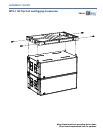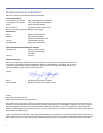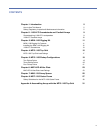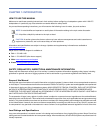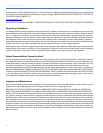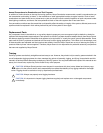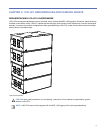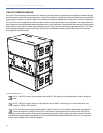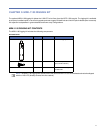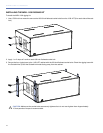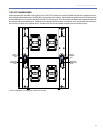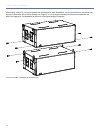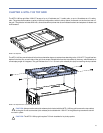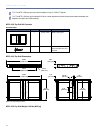
CHAPTER 1: INTRODUCTION
6
All load ratings and other specifications given in this manual are the result of accepted engineering practice and careful test-
ing. However, such specifications and ratings are subject to change. USERS SHOULD CHECK THE QUICKFLY SECTION OF
THE MEYER SOUND WEBSITE AT
www.meyersound.com
OR CONTACT TECHNICAL SUPPORT AT REGULAR INTERVALS TO CHECK FOR UPDATED OR REVISED INFORMATION.
Regulatory Compliance
The design and safe working load (SWL) ratings of the QuickFly system are intended to be in compliance with all known reg-
ulatory statutes currently applicable in the United States. Unless otherwise specified, all working loads are based on either a
5:1 or 7:1 safety factor. However, as noted above, there are wide variations internationally in the regulations and practices
applying to suspension of sound systems in public places. Although regulations in the United States are generally among the
most stringent, safety codes may be even stricter other localities (such as those highly prone to earthquakes). In addition,
applicable safety codes are open to interpretation: Government officials in one location may have a stricter interpretation than
another local official, even when operating under the same regulations and in the same legal jurisdiction.
Consequently, users of QuickFly rigging systems should be prepared to take additional safety assurance measures beyond
those outlined in this manual. In all cases, it is the responsibility of the user to make certain that any Meyer Sound loudspeaker
system is suspended in accordance with all applicable national /federal, state /provincial, and local regulations.
Safety Responsibilities “Above the Hook”
In most touring applications of rigging systems, the touring sound provider is normally responsible for ensuring the safety of
the suspension system only below the attachment point. The safety and suitability of the attachment point is generally seen
as the responsibility of the venue owner or operator. However, this distinction (“above the hook” versus “below the hook”) can
be open to interpretation. Touring system operators should double-check to make certain that attachment points are
approved and suitably load rated, and that the points used are those identified as such by the venue owner or operator. AS
AN EXTRA PRECAUTION, CAREFUL INSPECTION OF THE ATTACHMENT POINTS IS ADVISED BEFORE FLYING, PARTIC-
ULARLY IN OLDER VENUES OR THOSE HOSTING FREQUENT EVENTS USING LARGE SOUND AND LIGHTING SYSTEMS.
In any case, Meyer Sound QuickFly systems are intended only for suspension from approved rigging points, each known to
have ample SWL margins for the system components suspended below them.
Inspection and Maintenance
Meyer Sound QuickFly systems are an assembly of mechanical devices, and are therefore subject to wear and tear over pro-
longed use, as well as damage from corrosive agents, extreme impact, or inappropriate use.
BECAUSE OF THE SAFETY ISSUES INVOLVED, USERS MUST ADOPT AND ADHERE TO A SCHEDULE OF REGULAR
INSPECTION AND MAINTENANCE. IN TOURING APPLICATIONS, KEY COMPONENTS MUST BE INSPECTED BEFORE
EACH USE. Such inspection includes examination of all load-bearing components for any sign of undue wear, twisting, buck-
ling, cracking, rusting, or other corrosion. In regard to rust and corrosion, the main components of a QuickFly system are either
protected by an exterior coating or made from stainless steel, which is impervious to rust and resistant to most corrosive flu-
ids. Nevertheless, normal use and shipping vibrations can wear through the protective coatings, and extremely corrosive fluids
(such as battery acid) can cause severe damage with prolonged exposure even to protected parts. Particular attention should
be given to screws, bolts, and other fasteners to make certain the fittings are tight and secure. Metal seams and welds should
be examined for any sign of separation or deformation. Meyer Sound strongly recommends that written documentation be
maintained on each QuickFly system, noting date of inspection, name of inspector, points of system checked, and any anom-
alies discovered.



